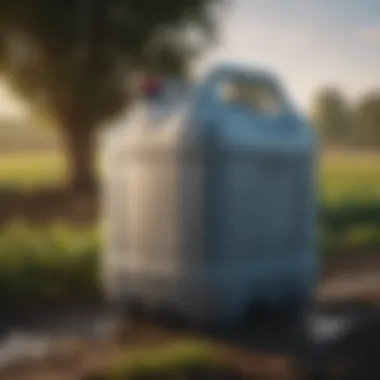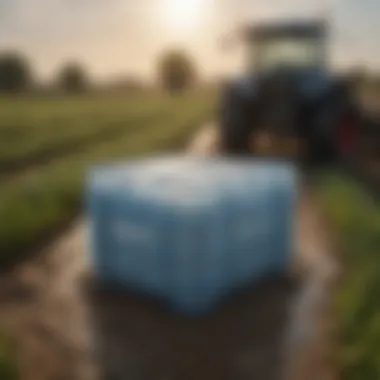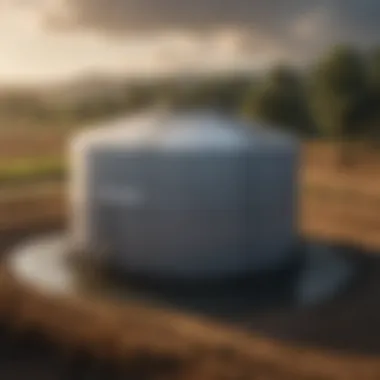Exploring 250 Gallon Water Totes in Agriculture


Intro
The topic of water management is increasingly critical in agriculture. Farmers and agronomists look for efficient ways to store and manage water. 250-gallon water totes have gained attention for their versatility and practicality. Their utility is not only in their size but also in the adaptability they offer. Understanding how these totes function within various agricultural contexts is essential for maximizing their benefits.
Topic Overview
Definition and Importance
Water totes are containers designed to hold substantial volumes of water. The 250-gallon water tote specifically offers a balance between capacity and mobility. This size is suitable for both smaller operations and larger farming practices. They can be used for irrigation, livestock drinking water, and even for mixing fertilizers.
The importance of these totes in agriculture cannot be overstated. Efficient water management spurs productivity, reduces waste, and can significantly cut costs. Farmers adopting these solutions can enhance their operations while contributing to sustainable practices.
Brief History and Evolution
Water storage in agriculture has a long history. Traditional methods often involved open tanks or ponds. However, these techniques faced limitations concerning hygiene and accessibility. Over time, more sophisticated containers emerged, leading to the development of water totes.
The evolution of 250-gallon water totes can be traced back to the increasing need for efficient water usage. Manufacturers designed these totes to withstand various environmental conditions and fit multiple needs in agricultural settings.
Key Techniques and Innovations
Sustainable Farming Practices
Sustainability is at the forefront of modern agriculture. Using 250-gallon water totes for collection and storage can minimize the carbon footprint. Rainwater harvesting is an excellent example. By placing totes strategically, farmers can capture rain for later use.
Implementing drip irrigation systems connected to these totes allows precise water application. This method ensures crops receive adequate moisture without wastage. Moreover, it fosters responsible water management practices.
Advanced Agronomic Technologies
Technological advancements have streamlined the integration of water totes in agriculture. Sensors can be installed in the totes to monitor water levels and quality. This data empowers farmers to make informed decisions about water usage and crop hydration.
Mobile apps that track weather patterns complement this technology. They enable farmers to plan irrigation based on real-time data. The fusion of water totes and modern technology offers an innovative approach to traditional farming methods.
Practical Applications
Step-by-Step Guides
- Selecting the Right Location: Choose an area where rainwater naturally collects.
- Installing the Tote: Position the tote securely, preferably elevated for gravity-fed distribution.
- Connecting Irrigation Systems: Use hoses or pipes to transport water from the tote to the plants.
- Monitoring Water Levels: Regularly check the tote's water level, using sensors for efficiency.
- Cleaning and Maintenance: At least twice a year, clean the tote to prevent algae growth.
Case Studies or Real-World Examples
Many farms have successfully implemented 250-gallon water totes. For instance, a local farm in Oregon reported a 30% reduction in water usage after integrating these totes into their irrigation practices. Another example involves a community garden that utilizes totes for rainwater collection, helping them maintain a sustainable growth cycle.
"The adoption of water totes has not only optimized our irrigation but also encouraged us to adopt a broader sustainable approach to farming." - Farmer from Oregon
Epilogue
The utility of 250-gallon water totes in agriculture is clear. From enhancing water efficiency to supporting sustainable practices, these tools can greatly benefit farmers and agronomists alike. With the evolving landscape of agricultural practices, understanding and implementing these storage solutions is vital to fostering resource efficiency and environmental responsibility.
Preface to Gallon Water Totes
The consideration of 250-gallon water totes holds significant relevance in agricultural practices. These containers are designed to enhance water storage capabilities, thereby influencing irrigation, crop management, and sustainable farming. Effective water management is critical for agricultural productivity. Understanding how these totes function can aid farmers, gardeners, and agronomists in optimizing their water usage. This section will explore essential aspects, including definitions, common materials, and the historical development of water storage solutions, to provide a thorough background on the topic.
Definition and Specifications
A 250-gallon water tote is generally a large, portable tank designed for the efficient storage and transportation of water. These totes typically consist of a polyethylene structure, which ensures both durability and resistance to environmental factors. The dimensions of a standard 250-gallon water tote usually range approximately from 40 to 50 inches in length and 30 to 40 inches in width. Their design often incorporates a vented fill lid, as well as a specialized drainage valve for easy and controlled dispensing. These specifications contribute to the overall efficiency and usability of the totes in agricultural settings.
Common Materials Used


The construction materials for 250-gallon water totes are key for their functionality and longevity. The most prevalent material is high-density polyethylene (HDPE), known for its resilience and resistance to UV rays, making it suitable for outdoor use. In some cases, totes may be made from stainless steel or fiberglass, but these alternatives tend to be less common. Each material has specific advantages. For instance, HDPE is lightweight and easy to handle, while steel may offer superior strength. Understanding these materials helps users select the best option for their unique agricultural needs.
The Evolution of Water Storage Solutions
Water storage solutions have seen substantial advancements over the years. Initially, farmers relied on predominantly natural sources, such as ponds or wells, which presented challenges regarding accessibility and water quality. Over time, technology has introduced various innovative systems, including underground cisterns and pump systems. However, the introduction of portable water totes represents another significant evolution. The 250-gallon water tote combines portability and efficiency, allowing for better adaptability in seasonal farming practices. This evolution reflects a broader trend in agriculture where flexibility and efficiency are prioritized, ensuring that water resources are used wisely and effectively.
Applications in Agriculture
The applications of 250-gallon water totes in agriculture are vital to understanding their multifaceted role. These totes provide significant benefits that can improve efficiency and sustainability in farming practices. By examining specific uses, we can assess not only their functionality but also how they fit into broader agricultural systems.
Irrigation Practices
Irrigation is crucial for crop growth, and the use of 250-gallon water totes can streamline this process. Farmers can store water in these totes for use when needed, ensuring that crops receive consistent hydration. This method helps in regulating the amount of water delivered, which is essential in maintaining the health of the crops. By using water totes, farmers can also implement drip irrigation systems more effectively.
Water stored in these totes can come from various sources, including municipal supplies, wells, or rainwater. Having a dedicated water source allows for better management, especially during dry spells. Additionally, it helps in reducing water waste.
Benefits of adopting totes for irrigation include:
- Flexibility: Water can be delivered directly to plants as needed.
- Scalability: Multiple totes can be used as farm size or crop variety increases.
- Cost reduction: Reduces reliance on costly irrigation systems.
Rainwater Harvesting
Rainwater harvesting is an efficient way to utilize natural resources, and 250-gallon water totes play an integral part in this system. Farmers can capture rainwater during rainfall events and store it for future use. This approach not only conserves water but also reduces soil erosion and runoff, benefiting the entire ecosystem.
Setting up a rainwater harvesting system with water totes is relatively straightforward. Key steps include:
- System Design: Assessing the area to strategically position the totes so they can capture maximum rainfall.
- Installation of Gutters: Redirecting roof runoff into the totes.
- Filtration: Employing filters to ensure water collected is clean and usable.
By implementing rainwater harvesting using 250-gallon totes, farmers can become less dependent on traditional water sources, thus promoting sustainability in agriculture.
Water Storage for Crop Management
Effective crop management hinges on adequate water supply and storage. 250-gallon water totes provide a reliable solution for storing water needed throughout the various growth stages of crops. During critical periods, such as germination or flowering, having immediate access to water can make a significant difference in yield outcomes.
Moreover, these totes can facilitate the storage of fertilizers mixed with water, which can be useful for crop feeding. By preparing ready-to-use solutions, farmers can save time and enhance their productivity.
Considerations for water storage using totes include:
- Location: Placing totes in shaded areas to minimize evaporation.
- Securing the Totes: Preventing contamination from outside materials.
- Monitoring Quality: Regular checks to maintain water cleanliness.
In summary, the applications of 250-gallon water totes in agriculture support essential aspects of farming, from irrigation to crop management and rainwater harvesting. This efficiency leads to improved sustainability and can significantly alter farming practices positively.
Benefits of Using Gallon Water Totes
The use of 250-gallon water totes in agriculture offers several significant advantages. Farmers, gardeners, and other agricultural professionals find these totes to be a valuable asset. Understanding these benefits is crucial when considering the implementation of water storage solutions.
Cost-Effectiveness
Cost management is critical in agriculture. 250-gallon water totes are relatively inexpensive compared to traditional storage methods like concrete tanks or large-scale reservoirs. The initial investment is often lower, and the durability of the totes means less frequent replacements. Additionally, these water totes can effectively reduce water bills. By optimizing water usage and gathering rainwater, farmers can save substantial amounts over time. Using these totes helps to mitigate risks associated with water shortages, ensuring that crops receive necessary hydration without incurring unnecessary costs.
Space Efficiency
Space is often at a premium in agricultural settings. Here, 250-gallon water totes showcase their value. Their compact sizes allow them to fit into limited areas without occupying excessive ground space. Unlike larger storage solutions, they can be strategically placed close to crop fields or irrigation systems. This arrangement minimizes the distance water must travel, leading to efficient irrigation practices. The modular design means that multiple totes can be deployed in various configurations based on specific farm layouts, enhancing overall space utility.
Portability and Versatility
The portability of 250-gallon water totes is another compelling benefit. These totes can be relocated easily, adapting to changing requirements or seasonal needs. For instance, during harvesting, a farmer may need to move water supplies closer to certain fields. The capability to shift these totes without excessive effort ensures that farmers can respond to immediate water needs efficiently.
Moreover, these totes are versatile in their applications. They can be utilized for multiple purposes including but not limited to irrigation, rainwater collection, and even livestock drinking water. As agricultural methods evolve, the ability to use water totes in various contexts like these becomes increasingly important.


"The versatility of 250-gallon water totes allows for innovative approaches to managing water resources in agriculture."
In summary, the benefits of using 250-gallon water totes play a vital role in enhancing agricultural efficiency, supporting sustainable practices, and addressing cost concerns. By understanding these advantages, farmers can make informed decisions on whether to integrate these water storage solutions into their operations.
Selecting the Right Water Tote
Selecting the right water tote is a crucial step for anyone involved in agriculture. The impact of this choice can greatly influence not only irrigation strategies but also overall productivity in the field. An optimal tote can enhance water efficiency, provide necessary storage space, and ensure that crops receive the adequate hydration they need. With various options on the market, understanding the specific requirements suited to one’s agricultural practices is imperative.
Choosing the Appropriate Material
The material of a 250-gallon water tote significantly affects how it performs under different conditions. Common options include plastic, metal, and fiberglass. Each material comes with its own advantages and drawbacks.
- Plastic is lightweight and generally resistant to corrosion, making it suitable for varied weather conditions. It is also less expensive, which can be a critical factor for many farmers. However, plastic can be less durable over time, especially when exposed to UV rays.
- Metal totes, often made from steel or aluminum, provide excellent durability and can withstand rough treatment. Yet, they are prone to rust unless coated appropriately; therefore, protective measures are crucial if choosing this material.
- Fiberglass offers a middle ground with high resistance to environmental factors. It does not corrode and can endure extreme conditions, though it may come at a higher cost compared to plastic options.
Ultimately, farmers should assess their local environmental conditions and usage frequency to choose the most suitable material.
Capacity Considerations
Capacity is another essential aspect to consider when selecting a water tote. While 250 gallons is a standard size, the specific needs of your agricultural setup can vary.
- Current Water Demands: Evaluate your water usage in peak seasons. Will 250 gallons cover your irrigation needs? A careful calculation can prevent future complications during drought or high-demand periods.
- Crop Types: Different crops may require varying amounts of water. If farming water-intensive crops, larger capacity might be necessary, or consider having multiple totes on hand.
- Scalability: If you plan on expanding your agricultural operations, choosing a 250-gallon tote might be a wise choice. However, also consider options for additional capacity as your needs grow.
Understanding these aspects helps in avoiding under- or over-investment in water storage solutions.
Additional Features and Accessories
Beyond the essentials, various features and accessories can enhance the function of 250-gallon water totes.
- Filtration Systems: Incorporating a filtration system ensures that the water stored is clean and suitable for agricultural use. This feature can help prevent contaminants from entering your crops.
- Ventilation: Adequate ventilation prevents the buildup of stagnant water, which can lead to odors or algae growth. Look for totes with features that promote air circulation.
- Drainage Valves: Incorporating a drain valve allows for quick and efficient drainage, thus facilitating easy cleaning and water management on the farm.
- Mobility Accessories: Wheels or handles can transform a stationary tote into a more mobile option, allowing you to transport water from storage to usage points more easily.
Choosing a tote with the right additional features can optimize water usage and improve the management of agricultural resources.
Best Practices for Maintenance
Maintaining 250-gallon water totes is essential for ensuring their longevity and effectiveness in agricultural use. Proper maintenance not only prolongs the life of the tote but also guarantees the safety of the water stored within. Regular care and attention to potential issues can significantly enhance the productivity of farm operations. In this section, we will detail key practices for cleaning and sanitizing, inspecting for damage, and storing these containers properly.
Cleaning and Sanitization
Regular cleaning is crucial to prevent algae growth and bacteria buildup in water totes. Ideally, a tote should be cleaned at least every six months. To clean the tote, use a gentle detergent and a scrub brush to remove any residues on the inner surfaces. Rinsing thoroughly is important to ensure no detergent remains. After that, sanitization should follow. A solution of one cup of unscented bleach per five gallons of water can be used. This solution should sit in the tote for several hours before being drained and rinsed completely. This process not only helps in keeping the water safe for irrigation but also maintains the integrity of the container.
Inspecting for Damage
Frequent inspections can reveal any signs of wear or damage, ensuring that small issues are addressed before they become serious problems. Look for cracks, leaks, or signs of corrosion. Pay special attention to the fittings and valve areas, as these are primary points of vulnerability. If a leak is detected, it is critical to repair it immediately. Depending on the material, this might involve patching or replacing specific sections. By regularly assessing the condition of the tote, farmers can avoid costly replacements and ensure a reliable water supply.
Proper Storage Techniques
When not in use, proper storage of the water tote is key to preventing damage and contamination. Store the tote in a cool, dry place, preferably away from direct sunlight. If possible, elevate it off the ground to prevent pests from entering. It is also advisable to drain the tote completely before storage to prevent any stagnant water. Keeping it covered can further minimize the risk of contaminants entering the container. Incorporating these storage techniques will help maintain the cleanliness of the tote and extend its service life.
"A well-maintained water tote not only protects the water quality but also enhances agricultural sustainability."
In summary, proper maintenance of 250-gallon water totes is a fundamental practice for all farmers and agricultural enthusiasts. By prioritizing cleaning, inspecting, and proper storage, farmers can ensure that their water totes serve their purpose effectively over the long term.
Environmental Considerations
Understanding the environmental considerations related to 250-gallon water totes is essential for promoting sustainable practices in agriculture. As farming faces challenges regarding resource management and ecological impact, examining this topic sheds light on both the benefits and potential drawbacks of using these water storage solutions.
Sustainability of Water Storage Solutions


The sustainability of water storage solutions, particularly 250-gallon water totes, centers on their role in efficient water management. These totes allow for the collection and storage of rainwater, reducing reliance on municipal water sources. This practice not only conserves water but also minimizes water runoff, which can lead to soil erosion and nutrient loss.
Using durable materials for these totes can extend their lifespan, contributing to less waste in landfills. For example, high-density polyethylene (HDPE) is a common material that is both recyclable and resistant to environmental stressors, making it an excellent choice for farmers aiming to reduce their ecological footprint.
Additionally, the portability of these totes aids in local food production efforts. Farmers can transport water directly to where it is needed, supporting localized irrigation practices that lessen the need for expansive irrigation systems that consume significant energy and resources.
Impact on Local Ecosystems
The impact of 250-gallon water totes on local ecosystems is a complex issue. While they provide an opportunity for better water management, improper use or neglect can lead to adverse environmental effects. Stagnant water in unmaintained totes can become a breeding ground for mosquitoes, potentially spreading diseases. Therefore, proper maintenance is vital to ensure that these water storage solutions do not create health hazards.
Also, the extraction of groundwater can have detrimental effects on local ecosystems. If farmers excessively rely on stored water without considering the balance of local water resources, it may lead to decreased water tables and affect nearby plants and wildlife.
Challenges and Limitations
The use of 250-gallon water totes in agriculture offers various advantages; however, it also presents certain challenges and limitations that must be acknowledged and addressed. Understanding these factors is essential for farmers and agricultural enthusiasts to optimize the utility of these water storage solutions. This section delves into critical considerations, including potential contaminants, regulatory compliance issues, and physical limitations encountered during the usage of these totes.
Potential Contaminants
Water quality is a vital aspect of agricultural practices. The presence of contaminants in water stored in 250-gallon totes can adversely affect crop health and soil quality. Sources of these contaminants may vary, including:
- Biofilm Formation: Over time, algae and bacteria may grow inside the tote. These microorganisms can release toxins, impacting water quality.
- Chemical Leaching: Certain materials used in the construction of water totes may leach harmful substances into the stored water. For instance, plastic totes might release chemicals if not made from food-grade materials.
- Debris Accumulation: Dust, leaves, and other debris can enter the water during collection or storage. This accumulation can lead to further contamination, necessitating regular maintenance and cleaning routines.
Farmers should routinely inspect and clean their water totes to minimize these risks. Implementing filtration systems can also enhance water quality and ensure argricultural practices remain safe.
Regulatory and Compliance Issues
Navigating the regulatory landscape is crucial for farmers utilizing 250-gallon water totes. Compliance with local, state, and federal regulations is mandatory to avoid legal consequences and ensure public health safety. Key issues to consider include:
- Water Quality Standards: Farmers must adhere to prescribed water quality standards, which dictate acceptable levels of contaminants in water used for irrigation.
- Permitting Requirements: Some regions may require permits for the collection and storage of rainwater or groundwater. Understanding local laws is essential to ensure compliance.
- Health Regulations: The agricultural sector is often subject to health regulations that govern the use of storage tanks. Farmers need to familiarize themselves with these regulations to avoid penalties and ensure safe agricultural practices.
Consulting with local agricultural offices can help clarify what regulations apply to specific agricultural practices concerning water usage.
Physical Limitations in Use
While 250-gallon water totes are designed for efficiency, they come with physical limitations that can restrict their utility in certain agricultural situations. These limitations include:
- Weight: When filled, a 250-gallon tote weighs approximately 2,000 pounds or more. This heaviness can complicate transportation and placement within fields. It requires careful planning and resources to move and position these totes without causing damage.
- Space Constraints: Farms may have limited space to accommodate multiple totes, especially in areas featuring uneven terrain or existing infrastructure. Farmers should evaluate site suitability before installation.
- Connection Compatibility: Not all fittings and hoses are universally compatible. Discrepancies in connectors might require additional adapters, increasing costs and complicating usage.
By being mindful of these physical challenges, farmers can take proactive steps in their planning and operations, ensuring maximum utility from 250-gallon water totes.
"Sustainable farming requires attention not only to benefits but also to potential challenges in practices."
Overall, acknowledging these challenges can empower farmers to utilize 250-gallon water totes effectively while mitigating risks associated with their use.
Ending
In the exploration of water storage solutions in agriculture, it is essential to understand the multifaceted role played by 250-gallon water totes. This conclusion synthesizes insights shared throughout the article, highlighting their benefits, utilization practices, and the environmental considerations that come into play.
Recap of Key Insights
The primary advantage of 250-gallon water totes lies in their versatility. They serve various functions, from irrigation to rainwater harvesting. Their cost-effectiveness and space-efficient design position them as must-have tools for modern agricultural practices. Proper cleaning and maintenance ensure the longevity of these totes, while awareness of potential contaminants guards against any adverse effects on crop health.
Farmers and agricultural enthusiasts can rely on these totes when faced with changing weather conditions and increasing water scarcity. The ability to efficiently store and repurpose water can potentially increase crop yields and ensure sustainable farming practices.
The adoption of water totes reflects an intelligent response to both agricultural demands and environmental challenges.
The Future of Water Storage in Agriculture
The future of water storage solutions in agriculture will likely see greater advancements and innovations. As farmland faces ongoing pressures from climate change, understanding the efficiency and adaptability of storage systems becomes crucial.
Emerging technologies such as smart water management systems may integrate with traditional 250-gallon totes. This integration could involve sensors that monitor water levels and quality, promoting data-driven agricultural practices.
Moreover, greater awareness of sustainable agriculture may lead to enhanced regulations surrounding water use and storage. Farmers are likely to increasingly consider eco-friendly materials and methods when selecting water storage options.
The importance of educational resources on best practices and maintenance will also grow. As farmers embrace these tools, they will need access to knowledge about the best materials and additional features suitable for their unique environments. Overall, the role of human ingenuity in optimizing water use will continue to shape the future landscape of agriculture.



